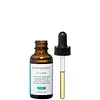What's inside
What's inside
 Key Ingredients
Key Ingredients

 Benefits
Benefits

 Concerns
Concerns

 Ingredients Side-by-side
Ingredients Side-by-side

Water
Skin ConditioningButylene Glycol
HumectantPropanediol
SolventEthylhexyl Olivate
Skin ConditioningCetearyl Alcohol
EmollientChlorogenic Acids
AntioxidantHydrolyzed Sodium Hyaluronate
Skin ConditioningLauryl Lactate
EmollientDimethyl Isosorbide
SolventGlycyrrhiza Glabra Root Extract
BleachingTetrahexyldecyl Ascorbate
AntioxidantErgothioneine
AntioxidantBenzylidene Dimethoxydimethylindanone
Skin ProtectingArabidopsis Thaliana Extract
AntioxidantCarnosine
Skin ConditioningCamellia Sinensis Leaf Extract
AntimicrobialVitis Vinifera Seed Extract
AntimicrobialTheobroma Cacao Seed Extract
AntioxidantCurcuma Longa Root Extract
MaskingOlea Europaea Fruit Extract
BleachingEuterpe Oleracea Fruit Extract
Trifluoroacetyl Tripeptide-2
Skin ConditioningBuddleja Officinalis Flower Extract
UV FilterCoffea Arabica Leaf Cell Extract
AntioxidantCrocus Sativus Leaf Cell Culture Extract
Skin ProtectingSuperoxide Dismutase
AntioxidantUbiquinone
AntioxidantZingiber Officinale Root Extract
MaskingCeramide NP
Skin ConditioningCeramide AP
Skin ConditioningCeramide EOP
Skin ConditioningLinoleic Acid
CleansingLinolenic Acid
CleansingSea Whip Extract
Skin ConditioningBisabolol
MaskingTocopherol
AntioxidantTocopheryl Acetate
AntioxidantCholesterol
EmollientPhytosphingosine
Skin ConditioningJojoba Esters
EmollientSodium PCA
HumectantPentylene Glycol
Skin ConditioningMethyl Gluceth-20
HumectantGlycerin
HumectantHelianthus Annuus Seed Wax
Skin ConditioningAcacia Decurrens Flower Wax
EmollientLecithin
EmollientSodium Lauroyl Lactylate
EmulsifyingDicetyl Phosphate
EmulsifyingPropanediol Dicaprylate/Caprate
EmollientPolyglycerin-3
HumectantCeteth-20 Phosphate
CleansingDiisostearyl Malate
EmollientXanthan Gum
EmulsifyingSteareth-2
EmulsifyingAcacia Senegal Gum
MaskingCarbomer
Emulsion StabilisingAcrylates/C10-30 Alkyl Acrylate Crosspolymer
Emulsion StabilisingDextran
Sodium Hydroxide
BufferingCitric Acid
BufferingDisodium EDTA
Ethylhexylglycerin
Skin ConditioningPhenoxyethanol
PreservativeWater, Butylene Glycol, Propanediol, Ethylhexyl Olivate, Cetearyl Alcohol, Chlorogenic Acids, Hydrolyzed Sodium Hyaluronate, Lauryl Lactate, Dimethyl Isosorbide, Glycyrrhiza Glabra Root Extract, Tetrahexyldecyl Ascorbate, Ergothioneine, Benzylidene Dimethoxydimethylindanone, Arabidopsis Thaliana Extract, Carnosine, Camellia Sinensis Leaf Extract, Vitis Vinifera Seed Extract, Theobroma Cacao Seed Extract, Curcuma Longa Root Extract, Olea Europaea Fruit Extract, Euterpe Oleracea Fruit Extract, Trifluoroacetyl Tripeptide-2, Buddleja Officinalis Flower Extract, Coffea Arabica Leaf Cell Extract, Crocus Sativus Leaf Cell Culture Extract, Superoxide Dismutase, Ubiquinone, Zingiber Officinale Root Extract, Ceramide NP, Ceramide AP, Ceramide EOP, Linoleic Acid, Linolenic Acid, Sea Whip Extract, Bisabolol, Tocopherol, Tocopheryl Acetate, Cholesterol, Phytosphingosine, Jojoba Esters, Sodium PCA, Pentylene Glycol, Methyl Gluceth-20, Glycerin, Helianthus Annuus Seed Wax, Acacia Decurrens Flower Wax, Lecithin, Sodium Lauroyl Lactylate, Dicetyl Phosphate, Propanediol Dicaprylate/Caprate, Polyglycerin-3, Ceteth-20 Phosphate, Diisostearyl Malate, Xanthan Gum, Steareth-2, Acacia Senegal Gum, Carbomer, Acrylates/C10-30 Alkyl Acrylate Crosspolymer, Dextran, Sodium Hydroxide, Citric Acid, Disodium EDTA, Ethylhexylglycerin, Phenoxyethanol
Ingredients Explained
These ingredients are found in both products.
Ingredients higher up in an ingredient list are typically present in a larger amount.
Citric Acid is an alpha hydroxy acid (AHA) naturally found in citrus fruits like oranges, lemons, and limes.
Like other AHAs, citric acid can exfoliate skin by breaking down the bonds that hold dead skin cells together. This helps reveal smoother and brighter skin underneath.
However, this exfoliating effect only happens at high concentrations (20%) which can be hard to find in cosmetic products.
Due to this, citric acid is usually included in small amounts as a pH adjuster. This helps keep products slightly more acidic and compatible with skin's natural pH.
In skincare formulas, citric acid can:
While it can provide some skin benefits, research shows lactic acid and glycolic acid are generally more effective and less irritating exfoliants.
Most citric acid used in skincare today is made by fermenting sugars (usually from molasses). This synthetic version is identical to the natural citrus form but easier to stabilize and use in formulations.
Read more about some other popular AHA's here:
Learn more about Citric AcidDisodium EDTA plays a role in making products more stable by aiding other preservatives.
It is a chelating agent, meaning it neutralizes metal ions that may be found in a product.
Disodium EDTA is a salt of edetic acid and is found to be safe in cosmetic ingredients.
Learn more about Disodium EDTAGlycerin is already naturally found in your skin. It helps moisturize and protect your skin.
A study from 2016 found glycerin to be more effective as a humectant than AHAs and hyaluronic acid.
As a humectant, it helps the skin stay hydrated by pulling moisture to your skin. The low molecular weight of glycerin allows it to pull moisture into the deeper layers of your skin.
Hydrated skin improves your skin barrier; Your skin barrier helps protect against irritants and bacteria.
Glycerin has also been found to have antimicrobial and antiviral properties. Due to these properties, glycerin is often used in wound and burn treatments.
In cosmetics, glycerin is usually derived from plants such as soybean or palm. However, it can also be sourced from animals, such as tallow or animal fat.
This ingredient is organic, colorless, odorless, and non-toxic.
Glycerin is the name for this ingredient in American English. British English uses Glycerol/Glycerine.
Learn more about GlycerinPhenoxyethanol is a preservative that has germicide, antimicrobial, and aromatic properties. Studies show that phenoxyethanol can prevent microbial growth. By itself, it has a scent that is similar to that of a rose.
It's often used in formulations along with Caprylyl Glycol to preserve the shelf life of products.
Water. It's the most common cosmetic ingredient of all. You'll usually see it at the top of ingredient lists, meaning that it makes up the largest part of the product.
So why is it so popular? Water most often acts as a solvent - this means that it helps dissolve other ingredients into the formulation.
You'll also recognize water as that liquid we all need to stay alive. If you see this, drink a glass of water. Stay hydrated!
Learn more about Water